Amphibians of North Cascades National Park: Their Importance, Sensitivity, Habitats, Threats and Management Implications
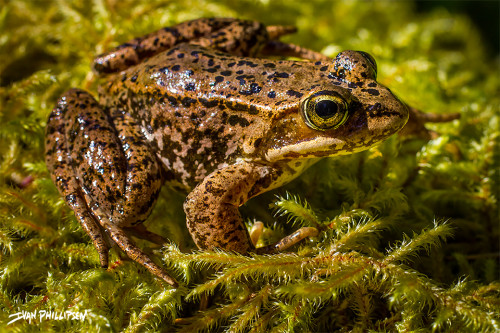
By Chelsea Elizabeth Ernst, Candidate for Master’s of Environmental Education
The North Cascades are a rugged and dramatic landscape that offers habitat to thousands of plant and animal species and is an epicenter for biodiversity in the contiguous 48 United States. The ecosystem within North Cascades National Park (NOCA) is a popular location for mountaineers and naturalists alike. Many of the people who visit NOCA come hoping to see one of its charismatic megafauna, including American black bear, grey wolf, or the elusive wolverine.
However, an often-overlooked group of organisms that thrive in the Park are amphibians. Not only are these creatures fun to search for and fascinating to study, they are an important contributor to the NOCA ecosystem. Wild and preserved places like NOCA offer amphibians a large landscape in which to thrive, in a world where their numbers are rapidly declining due to anthropogenic effects. Proper research, public education and management strategies can help maintain healthy populations in a group of organisms that are incredibly sensitive to human activity and global climate change.
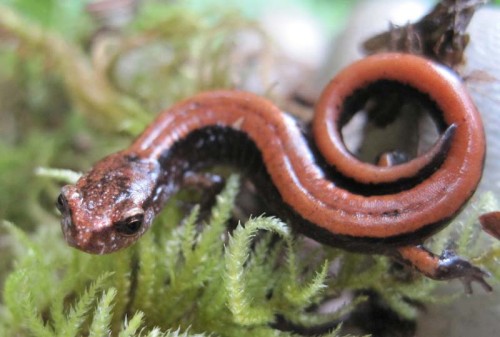
Western redback salamander
The Importance of Amphibians to Ecosystems and People
Due to the nature of amphibious life cycles, being both aquatic and terrestrial, they occupy multiple trophic levels — as predators, primary consumers, detritivores, cannibals, and either specialists or opportunists — and provide a variety of ecosystem services. (Hocking & Babbitt, 2014, pg. 6).
As larvae, many salamanders and frogs are aquatic and regulate nutrient cycling in streams, ponds, and riparian areas. Nutrient cycling contribution by amphibians is apparent in every stage of their life cycle: from eggs that do not hatch providing nutrients to larger riparian consumers to tadpoles scraping diatoms off of rocks. As adults, they can comprise a large portion of the biomass aquatic ecosystems.
Amphibians also play a role in providing ecosystem services that affect people. Frogs often eat insects that that are capable of spreading disease among humans. Culturally, frogs have been important as a clan totem for Native American tribes such as the Tlingit in Alaska. According to the Squamish Lilwat Cultural Center website (2011):
The frog is a sign to our people to put away the winter activities and prepare for a new season. The frog symbolizes cleansing, peace and rebirth. In Northwest Aboriginal Culture, a Frog is a great communicator and often represents the common ground or voice of the people. A Frog embodies magic and good fortune connected with shaman or medicine man and with spiritual and therapeutic cleansing. Frog’s songs are believed to contain divine power and magic. Frog is a messenger and communicator between species being valued for his adaptability because he freely travels between and survives in two worlds land and water, inhabiting both natural and supernatural realms. (Animal Symbology)
Frogs and salamanders have been important throughout history to humans physically and spiritually. They also provide nostalgia for many folks who enjoyed tromping about riparian areas as children in search of amphibious friends.
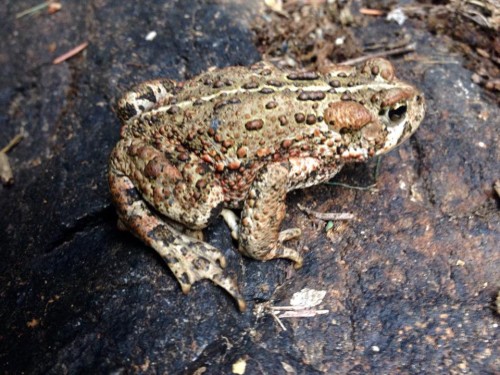
Amphibians’ Environmental Sensitivity
Amphibians are considered indicator species in the ecosystems they inhabit. When their populations decrease, it is often the first sign to humans that other organisms are at risk and that that ecosystem may be unhealthy. Certain aspects of amphibians’ physiology and ecology make them particularly sensitive to changes in ecosystems. As a result of these sensitivities to largely anthropogenic-induced fluctuations in their habitats, Hocking and Babbitt (2014) write that “amphibians are currently the most imperiled class, with approximately 41% of more than 7,000 amphibian species on the planet threatened with extinction” (pg. 1).
Because amphibians require water during part or all of their life cycle, climate change has a substantial impact on them. In the west, important amphibian habitats like high alpine lakes and montane wetlands are drying and warming (Ryan, Palen, Adams, & Rochefort, 2014). Their physiology makes them sensitive to climate change, among other environmental factors. Amphibians breathe cutaneously, absorbing moisture through their skin as part of their respiration process and to stay hydrated. They are ectothermic and require water to regulate their body temperature.
In addition to climate change, deforestation can affect this balance of moisture in ecosystems. Amphibian populations are also sensitive to UV light (Adams et al., 2005), diseases like Chytrid fungus (Chestnut et al., 2014), habitat fragmentation (Pilliod & Wind, 2008), and the introduction of non-native species to habitats (Ryan, Palen, Adams, & Rochefort, 2014).
With the variety of anthropogenic factors that have negative effects on amphibians and the increasing human population, the cause of worldwide amphibian vulnerability is clear. This highlights the importance of amphibian research in relatively untrammelled habitats like NOCA.
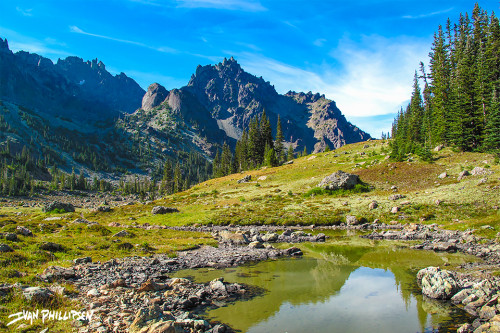
Amphibian Habitats in North Cascades National Park
NOCA is an ecosystem characterized by very steep vertical relief, weather patterns largely east-moving from the Pacific Ocean, and a landscape dramatically affected by glaciation. Due to the vertical relief of the mountains and orographic lift, there is a clear moisture gradient between the east and west sides of the Cascade Crest and a handful of distinct life zones. Life zones of the North Cascades include the lowland forest, alpine and subalpine, montane, and sagebrush steppe.
This wide range of life zones and variety of water sources—including streams, wetlands, and lakes—from large amounts of precipitation and runoff from over 300 glaciers—provides a variety of habitats for amphibians. However, even with this amount of moisture and habitat richness, areas of the United States with comparable annual precipitation have far more amphibian diversity than the North Cascades. According to Nussbaum, Brodie, and Storm (1983), “The major effect of Cascades on the herpetofauna of Pacific Northwest is that these mountains form a barrier for the lowland desert forms” (pg. 29), which presumably has an effect on the species found on each side of the Cascades Crest.
The twelve species of amphibians potentially found in NOCA are
- the tailed frog
- Pacific giant salamander
- Pacific tree frog
- red-legged frog
- Cascades frog
- Columbia spotted frog
- Western toad
- Northwestern salamander
- long-toed salamander
- ensatina salamander
- roughskin newt
- and Western redback salamander.
Each of these has preferred habitat areas within the Park.
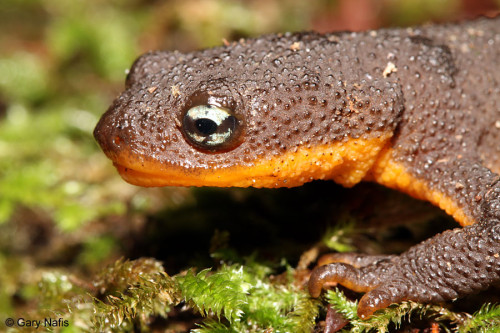
roughskin newt
Environmental Threats Affecting Amphibians of North Cascades National Park
NOCA is federally protected for the preservation of wildlife and 94% of its land is designated as the Stephen Mather Wilderness area. Two species that live in the park, the Western toad and Columbia spotted frog, are candidates for Washington state conservation status. Three are listed as federal species of concern, including the Red-legged frog, the Columbia spotted frog, and the Western toad. There are several environmental factors that occur within the Park that affect its amphibious species. Some of these factors include habitat alteration by dams, non-native trout stocking in high alpine lakes, and climate change.
The three dams along the Skagit River presumably create a large barrier between the two sides of the waterway and completely alter the habitat of the immediate area. More research is needed to determine the exact effect of these dams on amphibian populations.
Another anthropogenic effect on amphibians in NOCA is non-native trout stocking in high lakes. Accoring to Ryan, Palen, Adams, and Rochefort (2014), people began stocking trout in alpine lakes in the late 1800s for recreational angling. In the late 1800s, “the introduction of trout and other non-native fish species profoundly altered the biological structure and function of aquatic ecosystems through intense predation on native aquatic species, resulting in alterations to food was and nutrient dynamics” (pg. 233). The main amphibian affected by trout-stocking in these high lakes is the long-toed salamander.
Climate change also impacts amphibians, as previously mentioned, and wild places like NOCA are not exempt from its reaches. According to Ryan, Palen, Adams, and Rochefort (2014), “anthropogenic climate change…is imposing broad shifts in thermal environments and summer water availability.” Lack of water availability sometimes means that bodies of water can completely dry. Sensitive bodies of water include montane wetlands and high alpine lakes. Alpine lakes are becoming deadly to amphibians with the combination of trout stocking and climate change.
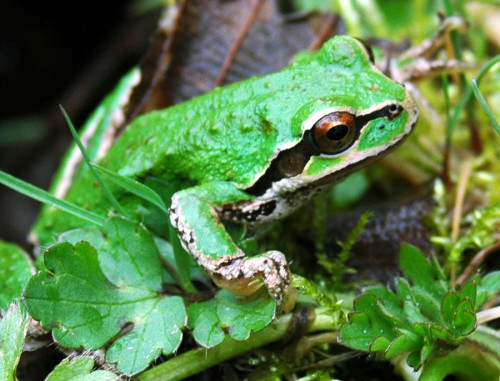
Pacific Tree Frog
Management
Since NOCA is a National Park containing federal wilderness, many management strategies suggested in Habitat Management Guidelines for Amphibians and Reptiles of the Northwestern United States and Western Canada (Pilliod & Wind, 2008) are already naturally implemented. These guidelines suggest strategies like retaining downed wood, retaining large trees and snags, maintaining habitat corridors and buffers, allowing natural beaver activity, minimizing logging, allowing lightning-sparked wildfires to burn, staying on roads and trails, and eradicating non-native plants. These are all readily practiced values in National Parks and are re-enforced by educating the public about environmental issues.
NOCA’s commitment to research, Leave No Trace values and educating the public are its strongest management strategies. Its partnerships and the people whose lives it touches mirror these values.
References
Adams, M.J, Hossack, B.R., Knapp, R.A., Corn, P.S., Diamond, S.A., Trentham, P.C, & Fagre, D.B. (2005). Distribution patterns of lentic-breeding amphibians in relation to ultraviolet radiation exposure in Western North America. USGS Staff-Published Research, Paper 97. Retrieved from http://digitalcommons.unl.edu/usgsstaffpub/97
Chestnut, T., Anderson, C., Popa, R., Blaustein, A.R., Voytek, M., Olson, D.H., & Kirshtein, J. (2014). Heterogeneous occupancy and density estimates of the pathogenic fungus Batrachochytrium dendrobatidis in waters of North America. PLoS ONE, 9(9), e106790.
Hocking, D.J., & Babbitt, K.J. (2014). Amphibian contributions to ecosystem services. Herpetological Conservation and Biology, 9(1), 1-17.
Nussbaum, R.A., Brodie, Jr., E.D., & Storm, R.M. (1983). Amphibians & Reptiles of the Pacific Northwest. Moscow, ID: University of Idaho Press.
Pilliod, D.S., & Wind, E. (Eds.). (2008). Habitat Management Guidelines for Amphibians and Reptiles of the Northwestern United States and Western Canada. Technical Publication HMG-4. Birmingham, AL: Partners in Amphibian and Reptile Conservation.
Ryan, M.E., Palen, W.J., Adams, M.J., & Rochefort, R.M. (2014). Amphibians in the climate vice: Loss and restoration of resilience of montane wetland ecosystems in the western US. Frontiers in the Ecology and the Environment, 12(4), 232-240.
Squamish Lilwat Cultural Centre. (2011). Animal Symbology. Retrieved June 4, 2015 from the Squamish Lilwat Clutural Centre website: http://shop.slcc.ca/node/5
Cascades frog (top photo) and habitat photo by Ivan Phillpsen.

